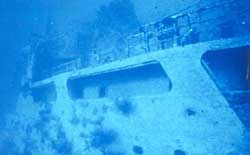Last updated: September 11, 2017
Article
US CG Cutter Duane

Photos courtesy of Indiana University and Underwater Archaeological Preserves, Florida Division of Historical Resources
As the oldest active U.S. military vessel, the Duane was decommissioned on August 1, 1985, and intentionally sunk for use as an artificial reef in 1987. The ship's hatches were opened and the holds pumped full of water to sink the ship. On a clear day, the outline of Duane's intact hull can be seen from above. The mast and crow's next, protruding high above the hull, can be seen at 60 feet below the water line. The navigating bridge is 70 feet, just forward of amidships. The superstructure deck is at 90 feet and the main deck lies at 100 feet. The hull structure is completely intact along with the original rudders, screws, railings, ladders, and ports. The structure is an impressive display. Duane offers advanced divers an exciting opportunity to explore an intact sunken ship that hosts an impressive community of marine life.
The USCG Cutter Duane lies upright on a sandy bottom in 125 feet of water one mile south of Molasses Reef off Key Largo. Located in the Florida Keys National Marine Sanctuary, the wreck is marked by two mooring buoys, one on the bow and one on the stern, at 24° 59.388' N and 80° 22.888' W. The ship receives thousands of visitors annually; check with local dive shops for further information.
Florida's Shipwrecks: 300 Years of Maritime History features a Teaching with Historic Places online lesson plan, The Spanish Treasure Fleets of 1715 and 1733: Disasters Strike at Sea. This lesson plan has been produced by the National Park Service's Teaching with Historic Places program, which offers a series of online classroom-ready lesson plans on registered historic places. To learn more, visit the Teaching with Historic Places home page.
